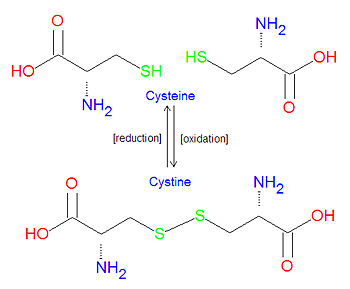Cystine: Difference between revisions
Jump to navigation
Jump to search

imported>Caesar Schinas m (Bot: Update image code) |
mNo edit summary |
||
| Line 4: | Line 4: | ||
'''Cystine''' refers to the oxidative linkage between two molecules of [[cysteine]], one of the common [[amino acid]]s, in the form of a [[disulfide bond]]. It may also refer to such a bond that occurs between two cysteine amino acids in a [[protein]]. Typically, intracellular proteins have few, if any, such disulfide bonds, while extracellular proteins tend to have several of them. | '''Cystine''' refers to the oxidative linkage between two molecules of [[cysteine]], one of the common [[amino acid]]s, in the form of a [[disulfide bond]]. It may also refer to such a bond that occurs between two cysteine amino acids in a [[protein]]. Typically, intracellular proteins have few, if any, such disulfide bonds, while extracellular proteins tend to have several of them. | ||
Such disulfide bonds are integral to the structural stability of many proteins. | Such disulfide bonds are integral to the structural stability of many proteins.[[Category:Suggestion Bot Tag]] | ||
Latest revision as of 16:01, 3 August 2024
Cystine refers to the oxidative linkage between two molecules of cysteine, one of the common amino acids, in the form of a disulfide bond. It may also refer to such a bond that occurs between two cysteine amino acids in a protein. Typically, intracellular proteins have few, if any, such disulfide bonds, while extracellular proteins tend to have several of them.
Such disulfide bonds are integral to the structural stability of many proteins.
